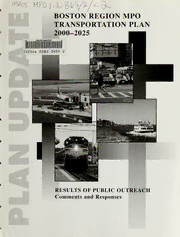
Boston region MPO transportation plan, 2000-2025 : plan update PDF
Preview Boston region MPO transportation plan, 2000-2025 : plan update
^ mfo i.a^BbysyV- "toff, VOLUME II Results of Public Outreach Comments and Responses Chapter Summaries of Public Outreach 1: Chapter 2: Written Comments - Abstracts, Responses, and Originals Chapter 3: Petition and Forms Chapter 1 Summaries of Public Outreach i Digitized by the Internet Archive 2014 in https://archive.org/details/bostonregionmpot02bost Outreach February 2002 c c c L - Summary ofPublicDiscussions On the Draft Plan Update and the DraftPublic Involvement Program February 2002 The Boston MPO conducted a series ofpublic discussions around the region to gathercomments on the draft Regional Transportation Plan and the draftPublic InvolvementProgram. The following notes summarize verbal public comments at the discussions. At each session, CTPS staffpresented an overview ofthe MPO process, the Plan Update, and the Public Involvementprogram. A member ofthe Traffic Analysis Group attended to address congestion management studies and other traffic issues. MPO representatives attended each session, usually opened the meeting, listened to comments, and tookpart in the discussions. Afterbriefplenary sessions, participants formed informal discussion groups. Citizenparticipants were invited to provide views onboth draft documents orally and in writing. Many comments were directly related to projects either included in the Plan or in the Universe ofProjects. Among other issues addressed were: MBTAservice planning. Congestion Management Studies, and the Unified Planning WorkProgram. Weymouth, February 5 Mayor David Madden, one ofseveral cosponsors ofthe discussion, opened the meeting. MPO representative. Barbara Lucas, and cosponsor Terry Fancher, South ShoreChamberofCommerce, made introductory remarks. Representatives from anothercosponsor, the South Shore Coalition subregion were in attendance. Mayor Madden said that the Naval Air StationConnectorproject, Route 3 South, and Route 18 improvements were top priorities for Weymouth and the region. Major highlights: Three projects ofmajor importance to the futureofthe area were identified: the Naval Air Station Connector, Route 18 Improvements, and Route 3 Widening. Also, there should be shuttle service to transit (including commuter boats), moreparking attransit, and more bus service (intra- and inter-community and regional.) The relationship between land use and transportationplanning was discussed. Comments voiced by multiple speakers: • The Naval Air Station Connector from Route 3, Route 18 improvements, and Route 3 Widening projects are critical for the South Shore (especially forWeymouth, Rockland, Hingham, and Abington). The region's developmentplans and economic vitality rely on these projects (which would also reduce congestion and improve safety). Theseprojects need to move forward quickly. There is terrible congestion at the Route 3/Route 18 ramps and this is a safety problem. The Naval Air Station can become a multi-modal facility and transportation hub for train, bus, and automobile modes. There should be a majortransitcomponent to thisproject. • There should be more bus transportation, particularly bus service to the Red Line, and to the existing South Weymouth and futureEastWeymouth commuterrail stations. There should alsobebetter regional bus service so that citizens could getto otherdestinations (from the BraintreeRed Line station to the South Shore Hospital, and park and fly services toTFGreene airport, forexample). • More parking is needed attransit stations. Wollaston and North Quincy stations fill up very early. Include parking at commuter boat terminals, especially Hingham Shipyard. Parkingconstraints limit use. The South Weymouth commuterrail station should beexpanded as structured parking. Other verbal comments: • The residential areas along Route 3 in Weymouth need noisebarriers and they should be partofany Route 3 project. • Extend theRed Line south along Route 3. 1 1 • TheRocklandParkandRide location and its neighboring land uses create a lotofcongestion. • Route 18 should be widened between the intersections. • TheForeRiverBridgerenovations are important to the region. • Sometimes privatedevelopers can become partners funding transportation improvements. • Intra-regional transportation should bediscussed, as well as transportation services to Boston. • The MPO shouldconductadiscussionfocusingon modeling and airquality. • Is itreasonabletobuild theGreenbush commuterrail line (to takecommuters outofcars) and then expandhighways? • Public transitshould serveeveryone. • Projects should beevaluated as a packageto understand local environmental impacts. • The Greenbush Line will not supporttheeconomic vitality ofothercities in the region. • Include abetterexplanationofhow model results influenceproject selection and air quality conformity issues. • WideningRoute 3 would undermine theprojected airquality benefits ofthe Greenbush project. • ThePlanneedsto pay more attentionto theregion's secondaryroads. There also was interest in whetherthe region isresponding to the September 1 th attack, whether the Plan shouldbe a vehicle toshiftdevelopmentpatterns by targeting transportation funds to a given area, improvementsat theBraintree Split, the 3C andMPO transportationplanning processes, and theRoute 228/53 intersection. Approximately thirtypeople attended this session. One participant submitted written comments atthe meeting. Lynn,February 6 Representatives fromthelocal sponsoringorganizations (theLynn Area ChamberofCommerce, the GreaterLynnSeniorServices, theSalemHarborCommunity DevelopmentCorporation, and the American Council ofEngineeringCompanies) and MAPC were in attendance. Arepresentative ofthe Mayorof LynnemphasizedthattheCity's top long-rangeplanningpriority isextending theBlue Line to Lynn. Majorhighlights: ExtendingtheBlueLinetoLynn is very importantto thecity. Transportation investmentscould go furtherto supporttransit-orienteddevelopment. There are unmet needs (particularly oftheelderly) forintra- and inter-communitytransportation in suburban areas. There is unmet demand for accessible transportation. Comments voicedby multiple speakers: • Extend the BlueLine toLynn. This iscritical totheeconomic futureofLynn. Investors and developerspreferrapid transit (with its short headways) tocommuter rail. The local labor market needs betteraccess to Boston and potential developers and employers would like good access from Boston toLynn. • TheBike-to-the Seaprojectis good forrecreational cyclists, butthedistance to Boston will reduce its usefulness as acommuter facility. • Theregionneeds morebus service, both intra-town and inter-town. Institutional issues between the MBTA and theCape AnnTransit Authority seem to interfere with intra-town service. Other verbal comments: • Transportationinvestments are simply encouraging more highway use and sprawl development. Transit-orienteddevelopment will requireconcerted effort before it will materialize. Several bottlenecks areespecially troublesome (1-95 in Saugus). TelecomCity is a good candidate for transit investment, but will havehighway investment instead. Transportation investment precedes development. • Shorten headways (improve service and maintenance offacilities) on existing commuterrail service. Reactivate several regional rail lines and spurs, which would naturally increase the numberof commuterrail trains attheLynn station. Connection to theBlueLine should not be at Wonderland.
